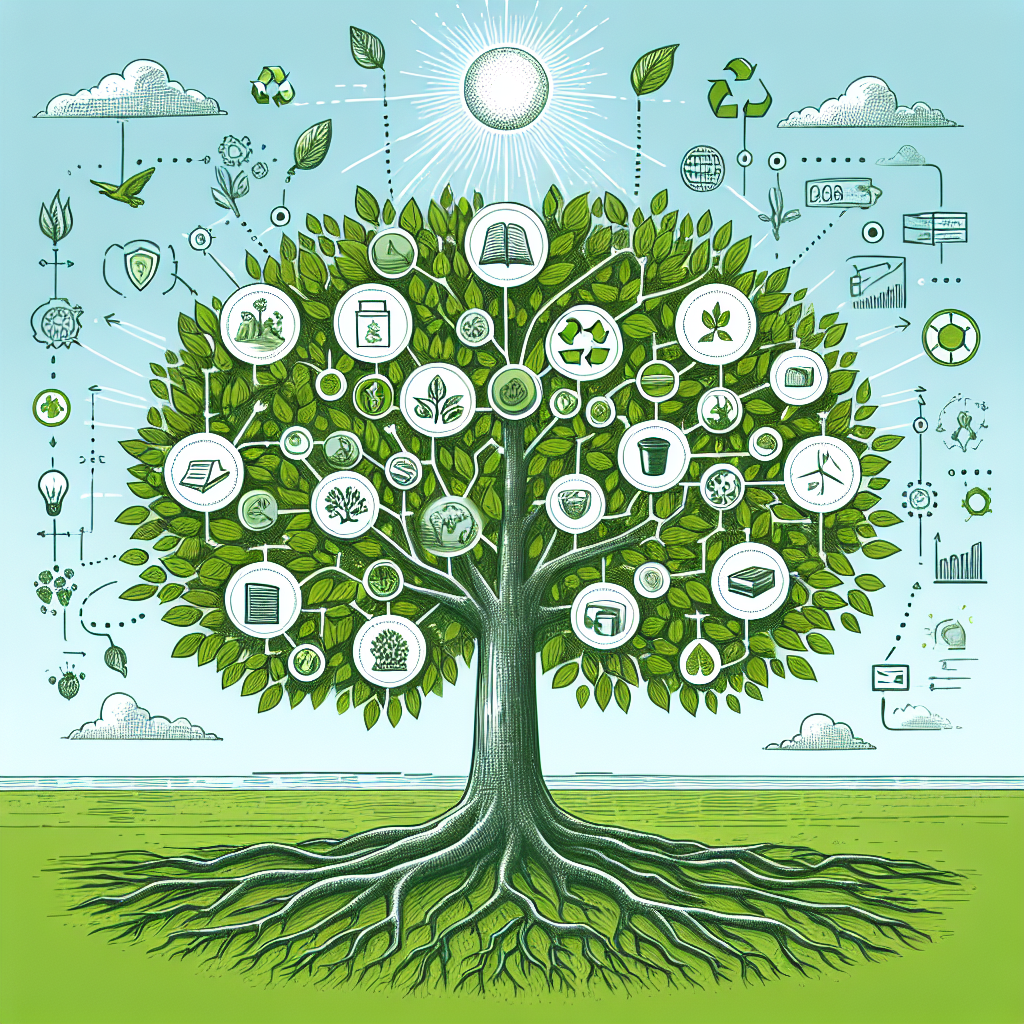
The Importance of Identifying Your Target Market for a Sustainable Business Model
Creating a sustainable business model is crucial for the long-term success of any business. It involves finding a balance between profitability and social responsibility, while also considering the impact on the environment. One key aspect of creating a sustainable business model is identifying your target market. In this article, we will discuss the importance of identifying your target market and how it can contribute to a sustainable business model.
First and foremost, identifying your target market allows you to tailor your products or services to meet the specific needs and preferences of your customers. This not only increases customer satisfaction but also reduces the risk of producing excess or unnecessary goods, which can lead to waste and harm the environment. By understanding the demographics, behaviors, and preferences of your target market, you can create products that are in demand and reduce the likelihood of overproduction.
Moreover, identifying your target market can also help you to develop effective marketing strategies. By knowing who your target audience is, you can tailor your marketing efforts to reach them more efficiently. This can save you time and resources, as you can focus on the channels and methods that are most likely to reach your target market. For example, if your target market is primarily young adults, you may want to focus on social media marketing rather than traditional print ads.
In addition, understanding your target market can also help you to make more informed business decisions. By knowing the needs and preferences of your customers, you can make strategic decisions about product development, pricing, and distribution. This can lead to more efficient use of resources and ultimately contribute to a more sustainable business model. For instance, if your target market values eco-friendly products, you may choose to invest in sustainable materials and packaging, which can attract more customers and align with your business values.
Identifying your target market can also help you to build a loyal customer base. By understanding the needs and preferences of your customers, you can provide them with a personalized and positive experience. This can lead to customer satisfaction and loyalty, as well as positive word-of-mouth recommendations. In turn, this can contribute to the sustainability of your business by reducing the need for constant marketing efforts and attracting repeat customers.
Furthermore, identifying your target market can also help you to stay ahead of the competition. By understanding your target market, you can identify any gaps or unmet needs in the market and develop products or services to fill them. This can give you a competitive advantage and attract customers who are looking for something unique or different. Additionally, by understanding your target market, you can also keep up with changing trends and preferences, ensuring that your business remains relevant and sustainable in the long run.
In conclusion, identifying your target market is a crucial step in creating a sustainable business model. It allows you to tailor your products and services to meet the specific needs and preferences of your customers, develop effective marketing strategies, make informed business decisions, build a loyal customer base, and stay ahead of the competition. By understanding your target market, you can create a business that not only generates profits but also contributes to a better and more sustainable world. So, take the time to identify your target market and incorporate their needs and preferences into your business model for long-term success.
Incorporating Sustainable Practices into Your Supply Chain for Long-Term Success
In today’s world, sustainability has become a crucial aspect of running a successful business. Consumers are becoming more conscious of the impact their purchases have on the environment, and they are actively seeking out companies that prioritize sustainability. As a business owner, it is essential to not only meet this growing demand but also to contribute to a better future for our planet. One way to do this is by incorporating sustainable practices into your supply chain. In this article, we will discuss how you can create a sustainable business model by implementing eco-friendly practices in your supply chain.
The first step in creating a sustainable business model is to assess your current supply chain practices. Take a close look at your suppliers and the materials they provide. Are they environmentally friendly? Do they use sustainable methods of production? If not, it may be time to consider switching to more sustainable suppliers. This may require some research and effort, but it will be worth it in the long run.
Once you have identified potential sustainable suppliers, it is essential to establish a strong relationship with them. Communication is key in any business relationship, and this is especially true when it comes to sustainability. Make sure to clearly communicate your expectations and goals for incorporating sustainable practices into your supply chain. This will help your suppliers understand the importance of sustainability to your business and encourage them to make necessary changes.
Another crucial aspect of creating a sustainable supply chain is to reduce waste. This can be achieved by implementing a circular economy approach, where resources are reused and recycled instead of being disposed of. This not only reduces waste but also saves money in the long run. For example, instead of using single-use packaging materials, consider using reusable or biodegradable options. This not only reduces waste but also sends a positive message to your customers about your commitment to sustainability.
In addition to reducing waste, it is also essential to minimize your carbon footprint. This can be achieved by optimizing transportation and logistics. Consider using alternative modes of transportation, such as electric or hybrid vehicles, to reduce emissions. You can also work with your suppliers to find ways to reduce the distance traveled for transportation. This not only reduces your carbon footprint but also saves on transportation costs.
Another way to incorporate sustainability into your supply chain is by promoting ethical and fair labor practices. This includes ensuring that your suppliers treat their workers fairly and provide safe working conditions. It is also important to ensure that your suppliers are not using child labor or engaging in any other unethical practices. By promoting ethical labor practices, you are not only contributing to a better world but also building a positive reputation for your business.
Finally, it is crucial to continuously monitor and evaluate your supply chain practices. This will help you identify any areas that need improvement and make necessary changes. It is also essential to stay updated on new sustainable practices and technologies that can be incorporated into your supply chain. By continuously striving to improve and innovate, you can create a truly sustainable business model that will benefit both your company and the environment.
In conclusion, incorporating sustainable practices into your supply chain is crucial for creating a sustainable business model. By assessing your current practices, establishing strong relationships with sustainable suppliers, reducing waste and carbon footprint, promoting ethical labor practices, and continuously monitoring and evaluating your supply chain, you can create a business that not only benefits the environment but also attracts environmentally conscious consumers. Remember, sustainability is not just a trend, but a necessary step towards a better future for all. So, take the first step towards a sustainable business model today and make a positive impact on the world.
Utilizing Technology to Create a More Sustainable and Efficient Business Model
In today’s world, sustainability has become a crucial aspect of running a successful business. Consumers are becoming more environmentally conscious and are actively seeking out companies that prioritize sustainability in their operations. As a business owner, it is important to not only meet these demands but also to create a sustainable business model that benefits both the environment and your bottom line. One way to achieve this is by utilizing technology to create a more sustainable and efficient business model.
Technology has advanced significantly in recent years, and it has become an essential tool for businesses of all sizes. By incorporating technology into your business operations, you can not only streamline processes but also reduce your environmental impact. One of the most significant benefits of technology is its ability to automate tasks, which can lead to increased efficiency and reduced waste.
One way to utilize technology for sustainability is by implementing a paperless system. With the rise of digital platforms and cloud storage, businesses can now store and access documents and data without the need for physical copies. This not only reduces the use of paper but also saves time and money spent on printing and storing documents. Additionally, by going paperless, businesses can reduce their carbon footprint and contribute to the preservation of forests.
Another way technology can help create a sustainable business model is through the use of renewable energy sources. Many companies are now investing in solar panels and other renewable energy sources to power their operations. This not only reduces their reliance on fossil fuels but also helps to lower their energy costs in the long run. By utilizing renewable energy, businesses can also reduce their carbon emissions and contribute to a cleaner environment.
In addition to reducing waste and utilizing renewable energy, technology can also help businesses track and analyze their energy usage. By using smart meters and energy management systems, companies can monitor their energy consumption in real-time and identify areas where they can make improvements. This data can then be used to make informed decisions on how to reduce energy usage and costs, ultimately leading to a more sustainable business model.
Technology can also play a significant role in supply chain management, which is another crucial aspect of creating a sustainable business model. By implementing supply chain management software, businesses can track and monitor their entire supply chain, from sourcing materials to delivering products to customers. This not only helps to reduce waste and inefficiencies but also ensures that suppliers are adhering to sustainable practices. By working with sustainable suppliers, businesses can further enhance their sustainability efforts and create a positive impact on the environment.
Furthermore, technology can also aid in the development of sustainable products and services. With the rise of 3D printing and other advanced manufacturing techniques, businesses can now create products using sustainable materials and processes. This not only reduces the use of non-renewable resources but also allows for more efficient production and customization of products. By offering sustainable products and services, businesses can attract environmentally conscious consumers and differentiate themselves from competitors.
In conclusion, technology has become an essential tool for creating a sustainable and efficient business model. By utilizing technology, businesses can reduce waste, lower their carbon footprint, and make informed decisions to improve their sustainability efforts. As a business owner, it is crucial to embrace technology and use it to your advantage in creating a more sustainable future for your company and the environment.
The Role of Corporate Social Responsibility in Building a Sustainable Business Model
In today’s world, consumers are becoming increasingly aware of the impact their purchases have on the environment and society. As a result, businesses are under pressure to not only make a profit, but also to operate in a socially and environmentally responsible manner. This is where the concept of corporate social responsibility (CSR) comes into play.
CSR refers to a company’s efforts to operate in an ethical and sustainable manner, taking into consideration the well-being of all stakeholders, including employees, customers, communities, and the environment. It is not just about making donations to charities or participating in volunteer activities, but rather, it is about integrating social and environmental considerations into the core business strategy.
So, how can a business use CSR to build a sustainable business model? Let’s take a closer look.
First and foremost, a company must identify its purpose and values. This means understanding the impact the business has on society and the environment, and aligning its values with those of its stakeholders. By doing so, a company can create a strong foundation for its CSR initiatives and ensure that they are in line with its overall business goals.
Next, a business must conduct a thorough assessment of its operations to identify areas where it can improve its social and environmental impact. This could include reducing carbon emissions, implementing sustainable sourcing practices, or promoting diversity and inclusion within the workplace. By identifying these areas, a company can set specific goals and targets to work towards, and track its progress over time.
One of the key ways in which CSR can contribute to a sustainable business model is by fostering a positive company culture. When a company prioritizes the well-being of its employees and creates a supportive and inclusive work environment, it can lead to increased employee satisfaction and retention. This, in turn, can result in higher productivity and better overall performance for the business.
Moreover, a company’s CSR efforts can also have a positive impact on its reputation and brand image. In today’s digital age, consumers have access to more information than ever before, and they are increasingly making purchasing decisions based on a company’s values and practices. By demonstrating a commitment to CSR, a business can attract and retain socially conscious consumers, which can ultimately lead to increased sales and revenue.
Another important aspect of CSR is community involvement. This can take many forms, such as supporting local charities, sponsoring community events, or implementing initiatives to benefit the local community. By engaging with the community, a business can build strong relationships and establish itself as a responsible and caring member of society.
In addition to these benefits, CSR can also lead to cost savings for a business. By implementing sustainable practices, such as reducing energy consumption or using eco-friendly materials, a company can reduce its operational costs in the long run. This not only benefits the environment but also contributes to the bottom line of the business.
It is important to note that CSR is not a one-time effort, but rather an ongoing commitment. A business must regularly review and update its CSR initiatives to ensure they remain relevant and effective. This could involve seeking feedback from stakeholders, conducting regular audits, and staying up-to-date with industry best practices.
In conclusion, corporate social responsibility plays a crucial role in building a sustainable business model. By aligning its values with those of its stakeholders, setting goals and targets, fostering a positive company culture, engaging with the community, and regularly reviewing and updating its initiatives, a business can create a strong foundation for long-term success. Not only does this benefit the environment and society, but it also contributes to the overall success and profitability of the business.
Strategies for Measuring and Tracking the Environmental Impact of Your Business Model
Creating a sustainable business model is becoming increasingly important in today’s world. As consumers become more environmentally conscious, they are looking for businesses that prioritize sustainability. Not only is it good for the planet, but it can also be beneficial for your business in the long run. However, creating a sustainable business model is not a one-time task. It requires continuous effort and monitoring to ensure that your business is making a positive impact on the environment. In this section, we will discuss some strategies for measuring and tracking the environmental impact of your business model.
The first step in measuring and tracking your business’s environmental impact is to establish a baseline. This means understanding your current practices and their impact on the environment. Conducting an environmental audit can help you identify areas where your business can improve. This could include energy consumption, waste management, and water usage. By understanding your current impact, you can set realistic goals for improvement.
Once you have established a baseline, it is important to set measurable goals for your business. These goals should be specific, achievable, and time-bound. For example, you could set a goal to reduce your energy consumption by 20% within the next year. By setting measurable goals, you can track your progress and make adjustments as needed.
One effective strategy for measuring and tracking your business’s environmental impact is to use a sustainability scorecard. This is a tool that allows you to track your progress towards your sustainability goals. It can also help you identify areas where your business is excelling and areas where there is room for improvement. There are many online tools and software available that can help you create a sustainability scorecard for your business.
Another important aspect of measuring and tracking your business’s environmental impact is to involve your employees. They are the ones who are on the ground, carrying out daily tasks that can have an impact on the environment. By involving them in the process, you can get valuable insights and ideas for improving sustainability practices within your business. You can also create a sense of ownership and responsibility among your employees, making them more likely to actively participate in sustainability efforts.
Regularly monitoring and tracking your business’s environmental impact is crucial for making progress towards your sustainability goals. This could include tracking your energy and water usage, waste generation, and carbon emissions. By keeping track of these metrics, you can identify areas where your business is doing well and areas where there is room for improvement. This will help you make informed decisions about where to focus your efforts.
In addition to tracking your own business’s impact, it is also important to consider the impact of your supply chain. This includes the environmental practices of your suppliers and the transportation of goods to your business. By working with environmentally responsible suppliers and optimizing your supply chain, you can reduce your business’s overall environmental impact.
Finally, it is important to communicate your sustainability efforts and progress to your stakeholders. This includes your customers, employees, and investors. By sharing your sustainability goals and progress, you can build trust and loyalty with your customers and employees. It can also attract socially responsible investors who are looking to support businesses that prioritize sustainability.
In conclusion, creating a sustainable business model requires continuous effort and monitoring. By establishing a baseline, setting measurable goals, using tools like sustainability scorecards, involving employees, and regularly tracking your impact, you can make progress towards a more environmentally friendly business. Remember to also consider your supply chain and communicate your efforts to stakeholders. By implementing these strategies, you can create a business model that not only benefits the environment but also your business in the long run.
We have lots of exciting coming events in Entrepreneurship, Investing and Personal Development. You can find them all here:
www.swedishwealthinstitute.se/events




